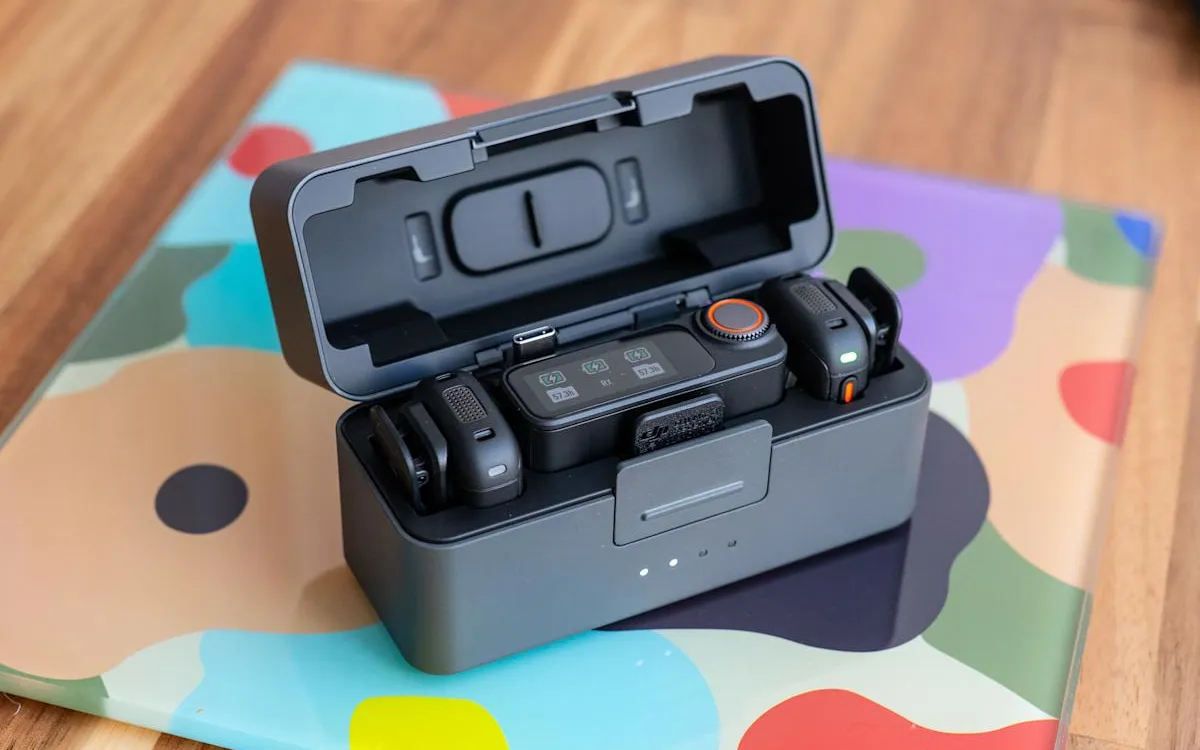
DJI's engineering team is once again pushing the boundaries of audio technology with the launch of the DJI Mic 3, the company’s third wireless microphone system in under two years. Building on the success of its predecessor, the Mic 2, the new flagship model features a complete design overhaul, coupled with significant enhancements in sound quality, noise reduction, and the capability to record multiple subjects simultaneously. However, it's worth noting that there is one feature that has seen a downgrade compared to the previous version. After testing the Mic 3 for over a week, this article will share my insights and experiences with this innovative microphone system.
The most striking change in the DJI Mic 3 is its compact design; the transmitter has been reduced to a mere 16 grams (0.58 ounces), a significant decrease from the 28 grams (0.99 ounces) of the Mic 2. Although it is slightly larger and heavier than the Mic Mini transmitter, which weighs just 10 grams, the new design offers improved transmitter mounting options. The Mic 3 introduces a rotating clip alongside a magnetic option, allowing for seamless attachment to clothing or hats. Additionally, users can choose from five different colors for the windscreen, making it easier to match the microphone to a subject’s outfit.
However, the prominent DJI logo on both sides of the transmitter remains a point of contention; while it may serve as free advertising, its appearance is less than aesthetically pleasing.
The charging case for the DJI Mic 3 is another area of improvement. It accommodates a receiver and two transmitters, and unlike its predecessor, now allows for the attachment of the magnetic mount and windscreen while charging. Each fully charged transmitter boasts a runtime of approximately eight hours, while the receiver can last up to ten hours. Impressively, the case can recharge all three devices up to 2.4 times, providing around 28 hours of extended usage. This feature is particularly beneficial for long shoots, a critical aspect that contributed to the original DJI Mic's success. It’s worth mentioning that competitors like Sennheiser have also introduced similar charging solutions.
One of the standout features of the Mic 3 is its ability to support up to four transmitters and eight receivers simultaneously. This means that recording four subjects at once to as many as eight receivers is now possible, making it ideal for multi-camera shoots—provided you purchase the additional kits. Although I could only test a single kit, this capability could be invaluable for larger production jobs.
To simplify the syncing process for audio and video, the Mic 3 is equipped with high-precision timecode capture, which is embedded during internal recording. I tested this feature using two cameras, and once I learned how to align the footage in DaVinci Resolve, it proved to be a significant post-production time-saver. Additionally, the receiver can be set to quadrophonic mode for select Sony cameras, allowing independent output of four channels to a single camera.
DJI has made substantial strides in audio quality with the Mic 3. It is the company’s first microphone to offer two adaptive gain control modes. The Automatic mode effectively suppresses sudden volume spikes in noisy environments, while the Dynamic mode adjusts the gain in real-time to maintain consistent loudness in quieter settings. I tested these features in both a calm studio environment and outside amidst city traffic, and I found that the Automatic mode efficiently minimized unwanted noise without compromising audio quality. Meanwhile, the Dynamic mode kept my speaking levels stable, even during softer speech, all without affecting voice clarity.
Furthermore, the Mic 3 comes with three tone presets (Regular, Rich, and Bright) designed to accommodate various voice characteristics. This flexibility allowed me to achieve better sound quality with less equalization, which was particularly effective on different vocal pitches. Two levels of active noise cancellation further reduce background sounds like air conditioning and wind noise, though this feature can slightly alter voice quality by reducing certain frequencies.
Another significant enhancement is the lossless audio feature, which allows the microphone to transmit uncompressed 48kHz 24-bit audio directly to the receiver, eliminating any MPEG audio artifacts. While this feature is more than sufficient for most users, it's essential to note that the sound quality, while impressive, may not rival that of high-end studio microphones.
The Mic 3 also introduces internal dual-file recording in 24-bit and 32-bit float formats, enabling the capture of the highest quality sound without any clipping. This allows for recording two files in 32-bit float without algorithmic changes, or one of each, which is a step up from the Mic 2’s single internal recording option.
However, it’s important to highlight a potential drawback for some audio professionals: the DJI Mic 3 does not feature a 3.5mm mic port for wired lavalier or other microphones, unlike the Mic 2. This limitation means users must rely on the built-in microphone, which, while high-quality, may not meet the demands of more rigorous applications such as broadcast.
On a positive note, the Mic 3 is compatible with DJI's OsmoAudio system, allowing for easy pairing with devices like the Osmo 360, Osmo Action 5 Pro, Action 4, and Osmo Pocket without the need for a receiver. I tested it with the Osmo 360 and Action 5 Pro, and the connection was seamless. For other devices, you can connect via a 3.5mm TRS port, TRRS monitoring, USB-C, or use Bluetooth capabilities with the included adapter.
The DJI Mic 3 is now available for purchase at a price point of $329 for a kit that includes a charging case, two transmitters, and a receiver. Alternatively, it can be bought separately for $219, which includes a single transmitter and receiver. With its advanced features and improved functionality, the DJI Mic 3 is poised to set new standards in the realm of wireless microphone systems.